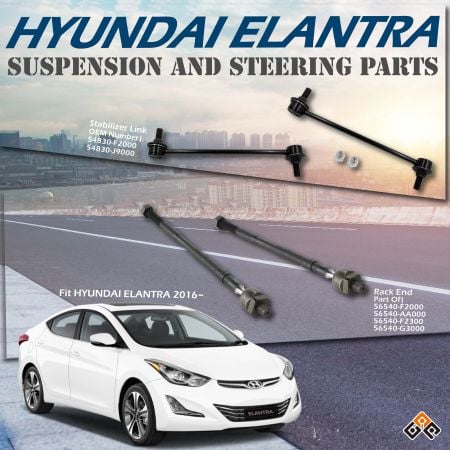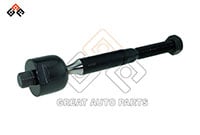How Worn Bushings Affect Car Suspension Performance
Ever felt your car wobble a little too much on turns or heard annoying clunking noises on bumpy roads? The culprit could be worn bushings, which is a tiny part with a huge impact. They don’t just mess with your car’s comfort; they throw off your steering, wear out your tires, and could even lead to costly repairs. Know into how these small suspension heroes keep your ride smooth and what happens when they fail.
Basics of the Suspension System
Suspension bushings are elastic components designed to absorb vibrations, cushion impacts, and connect suspension parts like control arms, stabilizer bars, and strut mounts. Typically made from rubber or polyurethane, these small but crucial components act as a buffer between metal parts, reducing noise and preventing wear caused by metal-to-metal contact. Their importance lies in maintaining a smooth ride, ensuring proper alignment, and protecting other suspension parts from excessive stress. Without functional bushings, your vehicle's performance, comfort, and safety can all be compromised.

How Do Bushings Work in a Car’s Suspension System
Think of bushings like tiny shock absorbers. They’re flexible enough to let parts move but tough enough to stop the bad stuff, like vibrations and metal-on-metal grinding. When your car hits a bump, bushings flex, absorb the impact, and stop it from reaching the cabin. They also hold suspension pieces in place, so things don’t get wobbly. Without them, your car would feel like a rickety rollercoaster.
Way Comparison of Bushing Performance in Different Vehicle Types
| Vehicle Type | Performance Characteristics | Recommended Bushing Type |
| Sedans | - Prioritize comfort and noise reduction for daily driving. - Minimize road vibrations. |
Soft rubber bushings for a smooth and quiet ride. |
| SUVs and Trucks | - Handle heavier loads and rough terrains. - Focus on durability and stability. |
- Stiffer or reinforced rubber bushings. - Polyurethane for off-road use. |
| Sports Cars | - Demand precise handling and reduced body roll. - Prioritize control over comfort. |
- Performance-oriented bushings with stiffer materials like high-density rubber or poly. |
| Heavy-Duty Vehicles | - Withstand extreme stress and heavy weights. - Support stability under tough conditions. |
- Leaf spring bushings or reinforced bushings for added strength. |
5 Major Signs of Worn Bushings
Recognizing the signs of worn bushings can help you avoid bigger problems. Common symptoms include:
-
Clunking or Squeaking Noises
When bushings wear out, they lose their ability to cushion parts effectively. This allows metal components to move and contact each other, creating clunking or squeaking sounds. These noises are most noticeable when driving over rough roads, hitting bumps, or making sharp turns. Liquid-filled bushings may also squeak as the fluid escapes or the bushing hardens over time. -
Loose or Unresponsive Steering
Bad bushings can cause excessive play in suspension and steering components. This makes the steering feel loose, imprecise, or unresponsive, especially at higher speeds. Drivers may also notice a slight delay in the car’s response when turning the wheel, which can make handling feel unsafe or unpredictable. -
Excessive Vibrations in the Steering Wheel
As bushings degrade, they struggle to absorb road vibrations effectively. This allows vibrations to transfer from the suspension into the steering system, making the steering wheel shake or vibrate while driving. The problem is often more noticeable on rough surfaces or at higher speeds, reducing driving comfort. -
Uneven Tire Wear
Worn bushings can cause misalignment in the suspension system, leading to uneven tire contact with the road. This uneven pressure accelerates tire wear, often showing up as bald spots or inconsistent tread patterns. Not only does this reduce the lifespan of your tires, but it also impacts your vehicle’s overall safety and handling.
If you notice any of these signs, it’s time to inspect your bushings and possibly replace them before they cause further damage.
Visual Indicators for Quick Diagnosis
Sometimes, you can spot worn bushings with a quick look during maintenance:
- Cracks or Tears: Visible splits in the rubber or polyurethane.
- Deformation: Bushings that look squished, sagging, or misshapen.
- Leaking Fluid: Liquid-filled bushings may leak when damaged.
- Excessive Movement: Suspension components may shift too much when bushings are worn.
Checking for these indicators can save time and prevent costly repairs.
5 Ways Worn Bushings Affect Steering and Handling
Worn bushings can dramatically change how your car handles and responds, leading to safety and performance concerns.
-
Loose or Unstable Steering
When bushings wear out, they allow too much movement in suspension components. This leads to loose or wobbly steering, making the car harder to control. You’ll notice this especially during sharp turns or high-speed driving. -
Poor Alignment and Increased Tire Wear
Worn bushings can throw off your car’s suspension alignment, which makes the vehicle drift or pull to one side. Misalignment also causes uneven tire wear, shortening the lifespan of your tires and making the car less predictable to handle. -
Excessive Body Roll During Turns
Good bushings help stabilize the vehicle during cornering. When they fail, you may notice more body roll, where the car leans heavily during turns. This can reduce your confidence in handling and make driving uncomfortable, especially on curvy roads.
-
Reduced Braking Efficiency
Failing bushings can cause suspension instability, which impacts braking performance. The car may pull to one side or feel unsteady during hard stops. This reduces braking efficiency and increases stopping distances, putting you at greater risk in emergencies. -
Increased Road Noise and Vibration
Bushings absorb road noise and vibration to keep your ride smooth and quiet. Worn bushings let more vibration and noise into the cabin, making the steering wheel feel rough and the overall driving experience less comfortable.
5 Ways Worn Bushings Damage Other Vehicle Components
Worn bushings don’t just cause handling and comfort problems, they can also lead to costly damage in other parts of your vehicle.
| Issue | Impact on Other Components | Affected Components |
| Misaligned Suspension | - Causes uneven tire wear, leading to shorter tire life and increased replacement costs. | Tires, control arms, suspension alignment parts |
| Excessive Stress on Components | - Overloads suspension and steering components, accelerating wear and risking component failure. | Control arms, tie rods, ball joints |
| Metal-on-Metal Contact | - Creates friction and damages parts, weakening structural integrity and causing noise. | Stabilizer bars, mounting points, suspension joints |
| Shock and Strut Damage | - Transfers vibration and stress, reducing performance and lifespan of suspension components. | Shocks, struts, strut mounts |
| Increased Repair Costs | - Leads to cascading failures, requiring expensive repairs to multiple components in the suspension system. | Entire suspension and steering systems |
Role of Advanced Materials in Bushings
Recent advancements in materials science have introduced innovative solutions for suspension bushings. Hybrid composites and thermoplastics offer greater durability and resistance to wear than traditional rubber, while graphene-infused rubber bushings provide enhanced flexibility and strength. Some manufacturers are even developing smart bushings with built-in sensors that monitor wear in real-time, making maintenance more precise and efficient. These advancements are setting new standards for performance and longevity in the automotive industry.
4 Environmental Impacts of Worn Bushings
| Impact | Description | Environmental Consequences |
| Increased Fuel Consumption | Misaligned suspension increases rolling resistance, requiring more energy to maintain speed. | Higher greenhouse gas emissions from burning more fuel. |
| Uneven Tire Wear | Misalignment causes tires to wear out faster, leading to frequent replacements. | Creates more tire waste, which contributes to landfill buildup and pollution. |
| Energy-Intensive Repairs | Damaged suspension parts require more labor and materials to repair or replace. | Higher carbon footprint from manufacturing and transporting replacement parts. |
| Reduced Vehicle Efficiency | A poorly maintained suspension system reduces overall vehicle efficiency. | Increased emissions and wasted resources over time. |




